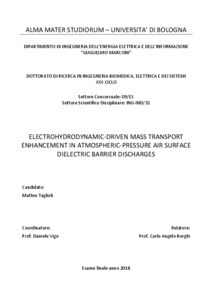Taglioli, Matteo
(2018)
Electrohydrodynamic-driven mass transport enhancement in atmospheric-pressure air surface dielectric barrier discharges, [Dissertation thesis], Alma Mater Studiorum Università di Bologna.
Dottorato di ricerca in
Ingegneria biomedica, elettrica e dei sistemi, 30 Ciclo. DOI 10.6092/unibo/amsdottorato/8420.
Documenti full-text disponibili:
![[img]](http://amsdottorato.unibo.it/8420/1.hassmallThumbnailVersion/Taglioli_PhD_thesis.pdf)  Anteprima |
|
Documento PDF (English)
- Richiede un lettore di PDF come Xpdf o Adobe Acrobat Reader
Disponibile con Licenza: Salvo eventuali più ampie autorizzazioni dell'autore, la tesi può essere liberamente consultata e può essere effettuato il salvataggio e la stampa di una copia per fini strettamente personali di studio, di ricerca e di insegnamento, con espresso divieto di qualunque utilizzo direttamente o indirettamente commerciale. Ogni altro diritto sul materiale è riservato.
Download (6MB)
| Anteprima
|
Abstract
Cold atmospheric-pressure plasmas have recently become subject of great interest for a wide variety of applications, including surface treatment and thin-film deposition. A driving force for development of room- temperature plasma applications is the avoidance of expensive equipment required for competing vacuum-based plasma technologies. During the last two decades, atmospheric-pressure electric gas discharges have drawn a lot of attention for their potential applications. In particular, surface dielectric barrier discharge plasmas have received renewed interest in recent years for emerging biomedical, environmental and agricultural applications.
In most of these processes, plasma is not in direct contact with the target being treated and reactive species transport to the substrate is typically assumed to be diffusion-controlled. This study shows how to engineer electrode patterns in order to take advantage of electrohydrodynamic forces and enhance reactive species delivery towards target under treatment. Novel surface dielectric barrier discharge devices with annular electrodes were fabricated. All devices were operated in atmospheric-pressure air, thereby leading to several reactive oxygen and nitrogen oxidising chemical compounds formation. Plasma local properties and electrohydrodynamic forces were experimentally investigated by means of several diagnostic techniques. Reactive species delivery was studied using several different chemical essays. Although all devices were driven at constant power density, therefore presenting constant plasma local properties, a 3-fold efficacy enhancement was observed for 30mm electrode diameter device. Biocidal efficacy was tested as well by treating Candida albicans. A 5-log reduction in the bacterial load was achieved after 5min of exposure to 30mm electrode diameter device powered with ~4W. Results presented and discussed in this work are quite encouraging. As it still remains an open challenge to generate uniform cold atmospheric-pressure plasma discharges, this study might provide basis for further research efforts addressing process scale-up and development of plasma devices for in-field large area biocidal purposes.
Abstract
Cold atmospheric-pressure plasmas have recently become subject of great interest for a wide variety of applications, including surface treatment and thin-film deposition. A driving force for development of room- temperature plasma applications is the avoidance of expensive equipment required for competing vacuum-based plasma technologies. During the last two decades, atmospheric-pressure electric gas discharges have drawn a lot of attention for their potential applications. In particular, surface dielectric barrier discharge plasmas have received renewed interest in recent years for emerging biomedical, environmental and agricultural applications.
In most of these processes, plasma is not in direct contact with the target being treated and reactive species transport to the substrate is typically assumed to be diffusion-controlled. This study shows how to engineer electrode patterns in order to take advantage of electrohydrodynamic forces and enhance reactive species delivery towards target under treatment. Novel surface dielectric barrier discharge devices with annular electrodes were fabricated. All devices were operated in atmospheric-pressure air, thereby leading to several reactive oxygen and nitrogen oxidising chemical compounds formation. Plasma local properties and electrohydrodynamic forces were experimentally investigated by means of several diagnostic techniques. Reactive species delivery was studied using several different chemical essays. Although all devices were driven at constant power density, therefore presenting constant plasma local properties, a 3-fold efficacy enhancement was observed for 30mm electrode diameter device. Biocidal efficacy was tested as well by treating Candida albicans. A 5-log reduction in the bacterial load was achieved after 5min of exposure to 30mm electrode diameter device powered with ~4W. Results presented and discussed in this work are quite encouraging. As it still remains an open challenge to generate uniform cold atmospheric-pressure plasma discharges, this study might provide basis for further research efforts addressing process scale-up and development of plasma devices for in-field large area biocidal purposes.
Tipologia del documento
Tesi di dottorato
Autore
Taglioli, Matteo
Supervisore
Dottorato di ricerca
Ciclo
30
Coordinatore
Settore disciplinare
Settore concorsuale
Parole chiave
EHD, DBD, S-DBD, CAP, plasma, cold atmospheric-pressure plasma, , low-temperature plasma, plasma sterilisation, plasma biology, plasma medicine, plasma chemistry, plasma physics, mass transport, plasma diagnostic, Schlieren, OES
URN:NBN
DOI
10.6092/unibo/amsdottorato/8420
Data di discussione
9 Maggio 2018
URI
Altri metadati
Tipologia del documento
Tesi di dottorato
Autore
Taglioli, Matteo
Supervisore
Dottorato di ricerca
Ciclo
30
Coordinatore
Settore disciplinare
Settore concorsuale
Parole chiave
EHD, DBD, S-DBD, CAP, plasma, cold atmospheric-pressure plasma, , low-temperature plasma, plasma sterilisation, plasma biology, plasma medicine, plasma chemistry, plasma physics, mass transport, plasma diagnostic, Schlieren, OES
URN:NBN
DOI
10.6092/unibo/amsdottorato/8420
Data di discussione
9 Maggio 2018
URI
Statistica sui download
Gestione del documento:


 Login
Login
